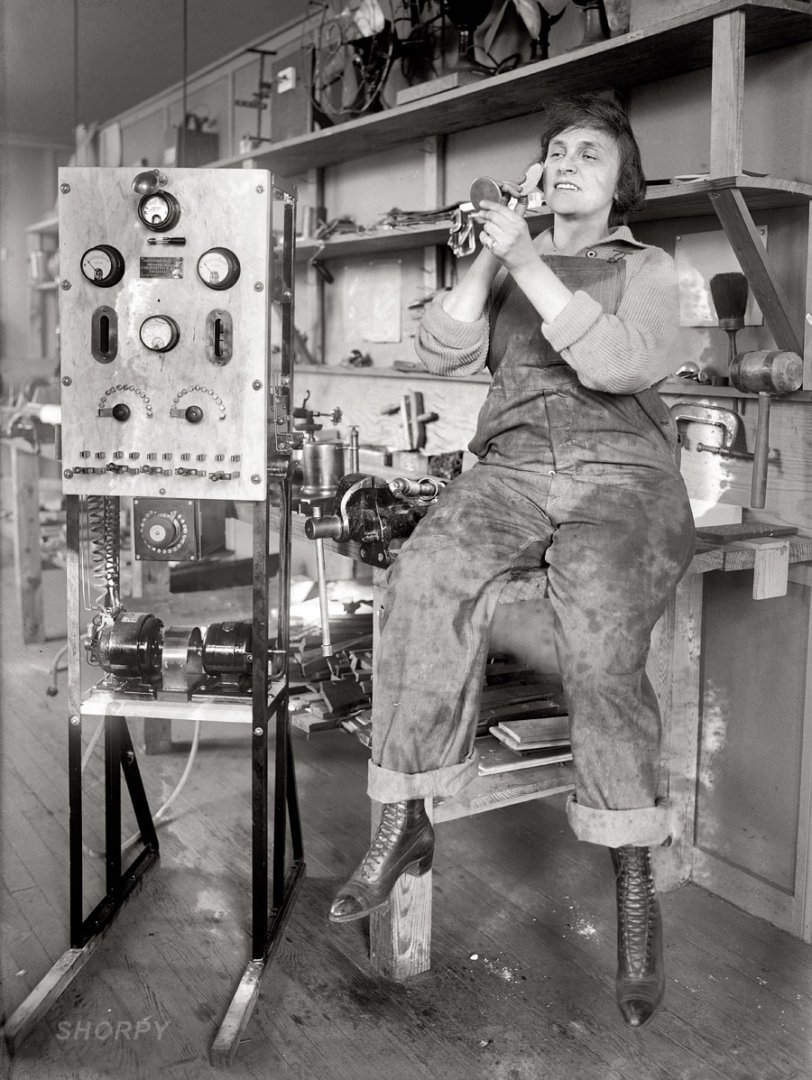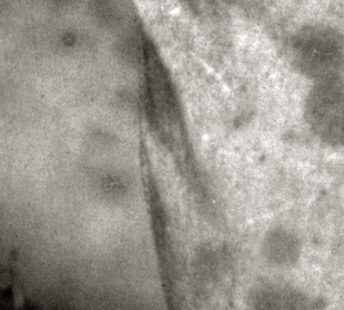


Framed or unframed, desk size to sofa size, printed by us in Arizona and Alabama since 2007. Explore now.
Shorpy is funded by you. Patreon contributors get an ad-free experience.
Learn more.

- Lofty addition
- In 1912
- Keenan Building
- Six years old
- Taken from the P.J. McArdle Roadway?
- It stood only 47 years
- Three track mind
- Incline to the right
- Reach for the sky, 1912 style
- No clean sweep
- Same Job Title, Same Face
- Sadly Lost
- Beautiful ...
- Where you get your kicks
- Aim High
- Pueblo Revival sisters
- Pueblo Neoclassicism
- Milk Man
- Regional dialect.
- Spielberg's inspiration
- Great Photo
- Loaf Story
- Do you still have the Rakes category?
- Could almost be a scene from the 1957 movie 'Hell Drivers'
- The Wages of Fear.
- Conspicuous by their absence
- Got Milk?
- All that aluminum
- No lefties
- Smoke 'em if you've got 'em
Print Emporium
Texanna Loomis: 1921

December 31, 1921. "Miss Texanna Loomis." Mary Texanna Loomis, founder and proprietor of the Loomis Radio School in Washington, D.C. National Photo Company Collection glass negative, Library of Congress. View full size.
More on the Loomis Family
You can learn about the Loomis family in America at our website www.loomis-family.org and we would like to hear from any of our extended family members who would like to connect with their family heritage.
Great-Aunt Mary
She is my great-aunt. Her sister Helen Loomis Wise was my mother's mother.
Radio Education: $3.50
Google has recently collaborated with Popular Science and Popular Mechanics to publish their magazine archives on the global network of tubes. Here's a 1927 ad from Mary Loomis' radio empire.
Money Making Opportunities
Press and public concede it to be the best ever produced. "Radio Theory and Operating" by Mary Texanna Loomis, member Institute of Radio Engineers, lecturer on radio, Loomis Radio College. Thorough text and reference book. 886 pages, 700 illustrations, price $3.50, postage paid. Used by Radio Schools, Technical Colleges, Universities, Dept. of Commerce, Gov't Schools and Engineers. At bookdealers, or sent on receipt check or money order. Loomis Publishing Company, Dept E, 405 9th St., Washington D.C.
Advertisement: Popular Science Monthly, Nov 1927
Fark Fodder
Introduction of indirectly-heated cathodes
Development of a tube using an indirectly-heated cathode (for AC power) began in September of 1926.
Westinghouse submitted working samples of their UX226 two months later. Commercial production began in early 1927, and the tube was announced for sale in November of that year. (Tyne pg. 319)
Ref: Tyne, Gerald F. Saga of the Vacuum Tube ISBN 0-672-21471-7 (hard), 0-672-21470-9 (soft)
Filament voltage
Motor-generators (a AC motor driving a DC generator) were used to power the filaments of the tubes but the amperage wasn't the issue -- it was the fact that in those days the filament was used as the cathode and if AC current was used to heat them it would induce hum in the signal. This is also why early home radios used batteries despite the availability of electricity (which was usually AC by the 1920s).
In the early 1930s they developed indirect heated cathodes where the filament was not a part of the signal circuit and it was then possible to power the filament from alternating current (through a transformer), eliminating the need for direct current from generators or batteries. Transmitters also used motor-generators for the plate voltage supply until mercury vapor rectifiers were developed.
[You took the words right out of my mouth! - Dave]
Motor-Generator
The unit could also be a AC motor driving a DC generator. The vacuum tubes would require a higher amperage than was available from a transformer circuit for same size. As I look at the unit with the step points, rheostats and meters it looks like a 1920's variable power supply.
Mary Loomis, 1880-1960
It seems she lived to the ripe old age of 80.
These Boots Were Made for Teachin'
Those shoes look to me as if they were 20 years out of style in 1921. Let's face it--Ms Loomis was not a typical lady of the day and old-fashioned shoes might have been as much part of her choosen self-presentation as overalls, heavy sweater, and powder on a face otherwise innocent of makeup.
The times (and the Post), they are a-changin'
I loved this bit of the Washington Post article:
... though she must be nearing middle age, her figure today has the lithe lines of the expert swimmer.
I doubt you'd see that in the Post today; the first part because we are no longer sensitive about publicizing a lady's age, and the second because we have become sensitive about describing a woman's figure. Funny how times change.
Grease
Who knew you could get your coveralls so greasy working on radios?
[Those splotches are mostly the emulsion going bad. - Dave]
Thanks for the information. You have to admit though that to someone who doesn't know about the state of the source material they do look like grease stains.
[They certainly do. Although if you look really close you can see they don't stop where the overalls do. - Dave]

Fuente de alimentación.
No exactamente. Se trata de un convertidor AC-DC. Una fuente de alimentación de voltaje variable para utilizar en el banco de pruebas.
Vanity
That is a powder compact, isn't it? If so, I love that she's touching up her face while wearing stained overalls. Attention to beauty rituals mixed with mechanical competence -- my kind of gal!
Spark gap? or?
Is that some sort of spark gap transmitter for morse to her left? or? The two electric motors imply rotation -- perhaps it is a higher frequency "anderson alternator" than the one shown in wikipedia? 73 de KG6HAF
Sensible shoes
Well, in all fairness to Ms. Loomis, this is long before "sensible shoes" became a euphemism, and decades before the word "lifestyle" entered the OED. At least she didn't fuss with shoe buttons.
Nonetheless, she seems like a woman who was quite comfortable with the life she led.
Perhaps her school was "men only" because she didn't need the distractions.
Extant Woman "Boss"
Washington Post, March 15, 1931
Mary Loomis "Bosses"
Air Students to High SuccessCousin of Dr. Loomis Has Varied Arts;
Master of Etheric ScienceAmong the folks in history count Miss Mary Texanna Loomis, the only extant woman "boss" of a radio college for men.
Miss Loomis, who is a regular octopus when it comes to having embraced different lines of activity, is the proprietor and founder of a well-known radio school. She is a cousin of Dr. Mahon Loomis, who is said to have obtained a patent on a device for sending messages without wires in 1872, some years before Marconi first announced his discoveries.
Many men successful in the varied fields of the radio industry got their first tutelage at the hands of Miss Loomis and she has high hopes for members of recent classes that graduated from her school. A textbook, "Radio Theory and Operating," now in its fifth edition, is one of Miss Loomis' proudest accomplishments. The work is in use in many schools, both government and private, all over the country.
Intense in all her pursuits, Miss Loomis had sports as her first interests in youth –- strenuous ones such as swimming, skating, horseback riding. Later she took a course in voice culture and became a talented soprano. Succeeding this she went to an art school and became adept at sketching. In swimming, particularly, she gained much note, and though she must be nearing middle age, her figure today has the lithe lines of the expert swimmer.
Born in Texas -– her middle name is taken from the State of her birth –- she later moved with her family to Rochester, N.Y., and there she received her early education. Not until the stirring early days of the war, when she was doing Red Cross work, did Miss Loomis get the radio "bug." From then on she devoted herself, body and soul, to learning all she could about this fascinating new wrinkle, and her judgment in selecting that field has been vindicated by the enormous development that method of communication has gone through in the last decade.
In 1919 the Department of Commerce issued a commercial radio operator's license to Miss Loomis, and this marked her first triumph in her chosen field. A year later she opened her school. Since then, she has turned out hundreds of men of all ages who have helped to meet the industry's demand for men trained in all its varied branches.
As a child she demonstrated a precocious skill with tools and quite often today she is seen with wrench and pliers working over the intricate machinery of Station WYRA, which is the official station of the school which bears Miss Loomis' name. Although much of her time is taken up with the executive matters of her school, she is frequently to be found in the laboratory making experiments with the elusive spark.
Administrative matters have usurped much of the time of the dynamic tutor of recent years, and this factor has forced her to abandon lecture work at her school. This fact she regrets very much, for she took a keen interest in vocally expounding her knowledge of the radio art.
Texanna
She's clearly a confident gal who is passionate about her work. But, oh my golly, those shoes. Before the popularity of tennis shoes as everyday wear, we certainly were a nation of sore feet.
























On Shorpy:
Today’s Top 5